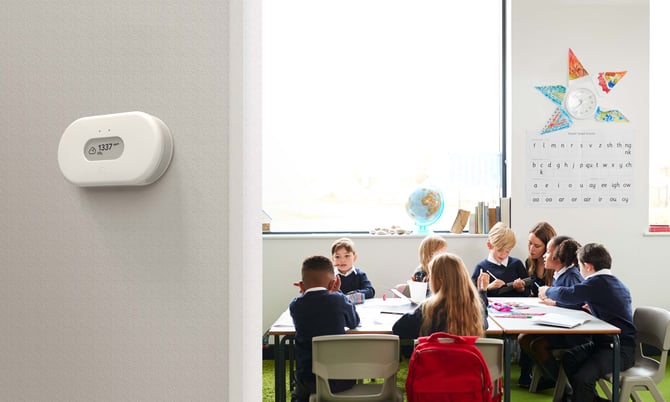Since the beginning of the Covid-19 pandemic, the importance of healthy air quality and ventilation within all indoor spaces has been at the fore of everyone's minds. Increasingly governments have been making funds available to both public buildings and schools to make air quality focussed changes that would increase the comfort, well-being, and safety of their occupants. The latest of these financial commitments has come from the U.S. where Massachusetts has just announced that $100 million will be made available in grants for air quality improvements in public schools.
 Why care about air quality in schools?
Why care about air quality in schools?
50% of schools in the US have been diagnosed with poor indoor air quality.1 Poor indoor air quality can decrease alertness, productivity, and test scores, as well as increase sick leave for both students and teachers. Studies show that classroom CO2 levels of 2500 ppm had much worse test scores than at 1000 ppm.2
For some time, experts have known that people think more clearly and get better test scores when they learn in an environment with cleaner air. It’s a particularly important issue in schools because children are considered to be more sensitive than adults to the effects of atmospheric pollution1.
Health and sick days are common issues in every communal environment including schools. Communicable diseases can frequently be transmitted through microscopic airborne droplets. These microscopic droplets can stay viable in the air for long periods of time and can result in the transmission of a virus from person to person if they are not displaced or avoided. Apart from the obvious health benefits, avoiding the transmission of illnesses can reduce the long-term effects of missed learning opportunities for a child. By monitoring the air quality metrics and room capacity you can determine the virus risk of space to its occupants. Want to learn more about
How the to obtain a grant for your school
The Massachusetts state funding is available through the American Rescue Plan Act (ARPA) bill and authorized by Chapter 102 of the Acts of 2021. As required by the ARPA bill, funds will be distributed by a formula to ensure the highest-need districts receive the largest portion of funding. More than 20 school districts are eligible for up to $1 million, and several districts qualify for several million dollars, with Boston Public Schools eligible to receive up to $15 million and Worcester Public Schools eligible for up to $7 million. “This grant funding will address the needs of school facilities and will support important repairs to improve ventilation and indoor air quality, particularly in schools and communities significantly impacted by COVID-19,” said Governor Charlie Baker.
%20-%20Lifestyle%20Classroom_PM_WEB%20(1).jpg?width=2000&name=Airthings%20Space%20Pro%20(formerly%20View%20Plus%20for%20Business)%20-%20Lifestyle%20Classroom_PM_WEB%20(1).jpg)
Eligible Massachusetts schools can contact us for more information here or at airthings.com/business/schools.
How can schools improve their indoor air quality?
Before you start investing in HVAC systems, ensuring windows are operable, and purchasing air purifiers you should first monitor your indoor air quality. In order to know how to improve your air quality, you need to know its issues first. Those issues can be high CO2, chemical fumes, dust, or indications that there is an increased virus risk in a classroom or other common areas. You can
1) Start monitoring the IAQ to create a baseline from which to chart your progress. This gives you the current status of their indoor air with metrics such as CO2, particulate matter (PM), volatile organic compounds, and more.
2) Use the air quality readings from your IAQ device to Identify areas of concern and the reason for the concern; drowsiness, headaches, and temperature.
3) Prioritize which pollutants should be eliminated first; CO2, dust, chemical fumes, etc.
4) Bring the RIGHT solution for their specific situation; a new HVAC system, window or ventilation repair, or energy savings by switching systems off after hours.
5) Keep monitoring to verify that the mitigation or energy savings solutions are working.
6) Communicate with the community to increase staff (And student) retention. Your air quality is something to be proud of and your teachers and students will feel the difference even if they can’t see the difference.
7) Move to data-driven discussions when complaints are made, no more guessing at what your IAQ issues are.
Additionally, Airthings has collaborated with the American Lung Association to produce a free indoor air quality guide for schools which you can view via the button below.

Would you like us to implement our IAQ solution for your school? Contact us to set up a demo at airthings.com/business/schools

 Most popular
Most popular
 NEW
NEW




 Radon
Radon
 Radon
Radon




%20-%20Lifestyle%20Classroom_PM_WEB%20(1).jpg?width=2000&name=Airthings%20Space%20Pro%20(formerly%20View%20Plus%20for%20Business)%20-%20Lifestyle%20Classroom_PM_WEB%20(1).jpg)

